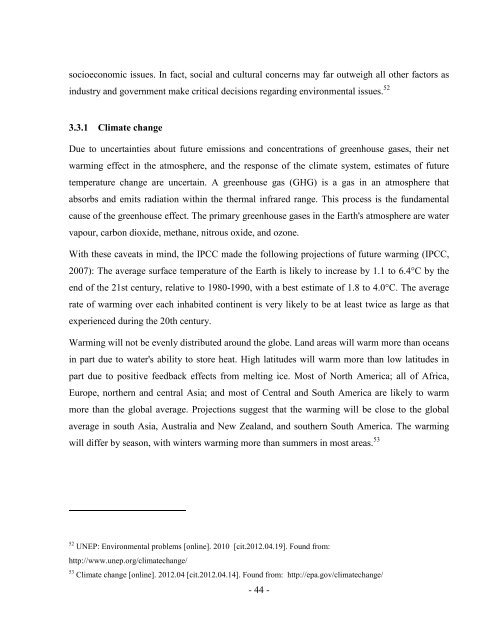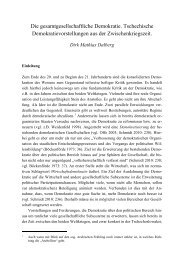University of Pardubice Jan Perner Transport Faculty Transport and ...
University of Pardubice Jan Perner Transport Faculty Transport and ...
University of Pardubice Jan Perner Transport Faculty Transport and ...
You also want an ePaper? Increase the reach of your titles
YUMPU automatically turns print PDFs into web optimized ePapers that Google loves.
socioeconomic issues. In fact, social <strong>and</strong> cultural concerns may far outweigh all other factors as<br />
industry <strong>and</strong> government make critical decisions regarding environmental issues. 52<br />
3.3.1 Climate change<br />
Due to uncertainties about future emissions <strong>and</strong> concentrations <strong>of</strong> greenhouse gases, their net<br />
warming effect in the atmosphere, <strong>and</strong> the response <strong>of</strong> the climate system, estimates <strong>of</strong> future<br />
temperature change are uncertain. A greenhouse gas (GHG) is a gas in an atmosphere that<br />
absorbs <strong>and</strong> emits radiation within the thermal infrared range. This process is the fundamental<br />
cause <strong>of</strong> the greenhouse effect. The primary greenhouse gases in the Earth's atmosphere are water<br />
vapour, carbon dioxide, methane, nitrous oxide, <strong>and</strong> ozone.<br />
With these caveats in mind, the IPCC made the following projections <strong>of</strong> future warming (IPCC,<br />
2007): The average surface temperature <strong>of</strong> the Earth is likely to increase by 1.1 to 6.4°C by the<br />
end <strong>of</strong> the 21st century, relative to 1980-1990, with a best estimate <strong>of</strong> 1.8 to 4.0°C. The average<br />
rate <strong>of</strong> warming over each inhabited continent is very likely to be at least twice as large as that<br />
experienced during the 20th century.<br />
Warming will not be evenly distributed around the globe. L<strong>and</strong> areas will warm more than oceans<br />
in part due to water's ability to store heat. High latitudes will warm more than low latitudes in<br />
part due to positive feedback effects from melting ice. Most <strong>of</strong> North America; all <strong>of</strong> Africa,<br />
Europe, northern <strong>and</strong> central Asia; <strong>and</strong> most <strong>of</strong> Central <strong>and</strong> South America are likely to warm<br />
more than the global average. Projections suggest that the warming will be close to the global<br />
average in south Asia, Australia <strong>and</strong> New Zeal<strong>and</strong>, <strong>and</strong> southern South America. The warming<br />
will differ by season, with winters warming more than summers in most areas. 53<br />
52 UNEP: Environmental problems [online]. 2010 [cit.2012.04.19]. Found from:<br />
http://www.unep.org/climatechange/<br />
53 Climate change [online]. 2012.04 [cit.2012.04.14]. Found from: http://epa.gov/climatechange/<br />
- 44 -

















